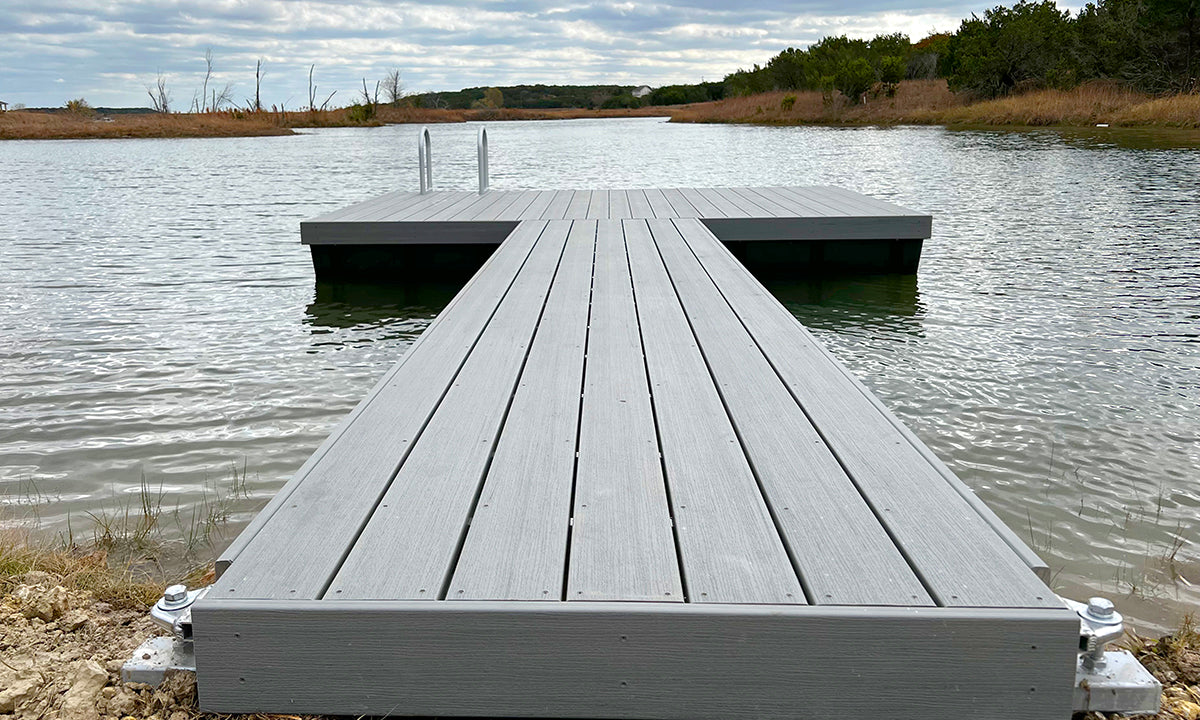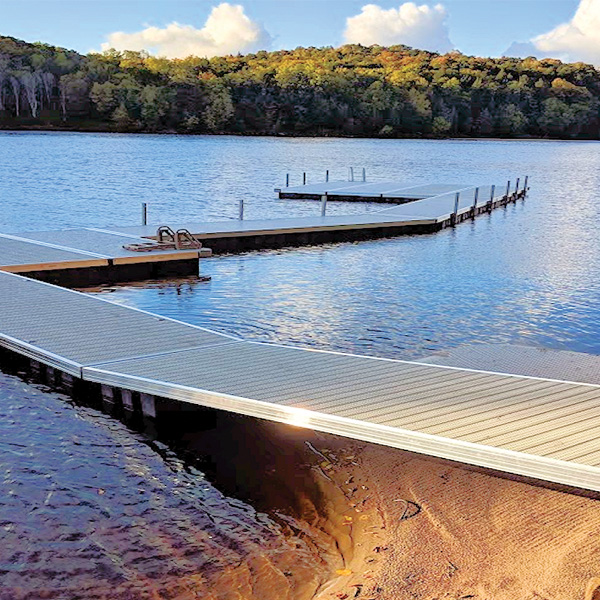Develop the Perfect Docking Remedy With Floating Docks
Floating docks existing a functional option for a selection of maritime demands, adjusting seamlessly to varying water levels and diverse vessel kinds. Their modular nature permits for rapid installation and relocation, yet the selection of suitable products and layout attributes is important for ensuring both functionality and visual allure. As we discover the necessary components that add to the efficiency of floating docks, numerous crucial aspects relating to stability and maintenance will certainly arise, questioning about just how to maximize your docking experience. The subsequent discussion will certainly light up these important considerations.

Advantages of Floating Docks
Floating docks offer many benefits that make them a perfect option for different maritime applications. Among the key advantages is their flexibility to changing water degrees. Unlike fixed docks, floating docks surge and loss with the trend, making certain consistent accessibility for vessels. This feature is especially essential in areas prone to significant tidal fluctuations or seasonal water level changes.
Furthermore, floating docks are commonly less complicated and quicker to mount contrasted to conventional fixed structures. Their modular layout permits simple assembly and disassembly, promoting maintenance and relocation when essential. This adaptability is particularly beneficial for momentary applications or in atmospheres where conditions might change.
Floating docks additionally have a tendency to be much more eco-friendly, as they minimize disturbance to the seabed and surrounding aquatic ecological communities. Their resilient nature reduces the threat of damage to aquatic life, promoting a much healthier environment. These docks can be tailored to fit numerous vessel sizes, making sure that they meet certain functional needs.
Eventually, the mix of adaptability, simplicity of installment, and environmental considerations makes floating docks a highly efficient option for a wide range of maritime demands.
Picking the Right Materials
Selecting the proper products for floating docks is vital to make certain longevity, sturdiness, and security. The choice of materials directly affects the dock's performance in numerous ecological problems, consisting of direct exposure to water, sunshine, and possible wear from aquatic website traffic.
Usual products made use of for floating docks include aluminum, wood, and high-density polyethylene (HDPE) Aluminum is lightweight, corrosion-resistant, and calls for marginal upkeep, making it a superb selection for long life. Its first expense can be higher compared to various other products.
Timber, while visually attractive and offering a standard look, can be vulnerable to rot and pest damages if not appropriately treated. Using pressure-treated timber or naturally durable varieties like cedar or redwood can alleviate these problems.
HDPE is a popular selection because of its resistance to UV rays and chemicals, along with being environmentally pleasant. floating dock company. It is offered and lightweight in numerous colors, enabling modification
Eventually, the right product choice will certainly depend on details demands, consisting of budget plan, wanted appearances, and environmental factors to consider. Cautious analysis of these elements will certainly result in a resilient and effective floating dock service.
Layout Considerations for Stability
When making floating docks, making certain stability is an essential facet that can substantially influence their functionality and security. Security in floating dock design is influenced by different aspects, consisting of buoyancy, weight distribution, and the plan of parts. An optimal buoyancy system must make use of products that provide adequate lift while decreasing weight. This equilibrium makes sure that the dock remains above water, even under varying tons.
Weight circulation is vital; evenly distributing tons throughout the dock prevents tilting and improves stability. This can be attained via calculated placement of docking devices, such as fenders and cleats, in addition to appropriate spacing of floats. Furthermore, the measurements of the dock should be attentively planned. Broader layouts can supply raised security, click here for more info specifically in rough water conditions, while longer docks may require extra supports to stop drooping.
An additional crucial consideration is the ecological effect, including wave activity and wind. Integrating features such as sidewalls or skirting can assist reduce the results of environmental pressures, preserving security in negative conditions. Inevitably, a combination of thoughtful layout, material option, and understanding of ecological elements will certainly produce a drifting dock that meets both security and safety needs.
Installation Tips and Strategies

Following, safeguard the necessary licenses and abide by local guidelines, which might dictate installment methods and ecological factors to consider. Involve a certified professional experienced in floating dock installations if required. Usage top notch materials developed for go to these guys marine settings to improve sturdiness and durability.
When positioning the dock, straighten it identical to the shoreline to facilitate very easy accessibility. Make certain that the anchoring system is robust, employing cinder block or helical supports to support the dock against wind and wave action. It's important to account for seasonal water degree changes, including potential ice activity in chillier environments.
Throughout the setup, confirm the dock's floatation and stability prior to completing the anchoring. Frequently inspect the installment for any indications of wear or damage. By adhering to these techniques and tips, you can achieve a secure, practical, and aesthetically pleasing floating dock setup that fulfills your demands.
Maintenance and Treatment Standards
Caring and preserving for floating docks is important to lengthening their lifespan and guaranteeing secure use. Regular evaluations need to be conducted to identify any type of indications of wear, damages, or aquatic growth. Look for fractures, loosened installations, or discolored areas on the dock's surface, as these problems can endanger architectural honesty.
Cleansing is essential. Use a pressure washer to eliminate algae, barnacles, and debris, which can collect with time. For persistent development, take into consideration environmentally friendly cleansing representatives that will not damage marine life.
In addition, examine the mooring lines and supports regularly to guarantee they are safe and secure and free from corrosion. Replace any frayed or damaged lines quickly to preserve stability.
Throughout severe weather condition, such as tornados or freezing conditions, take preventive actions. Protect the dock with extra mooring lines and, if feasible, get rid of any here are the findings kind of detachable parts to avoid damage.
Verdict
Finally, the application of floating docks offers a efficient and functional docking option appropriate for various maritime applications. Their flexibility to rising and fall water degrees, combined with a modular layout, permits easy customization and moving. Choosing appropriate products enhances both sturdiness and visual charm, while careful factor to consider of security ensures safety and security and durability. With proper setup and regular upkeep, floating docks can provide effective and trustworthy docking experiences for a broad array of vessels.
As we discover the important aspects that add to the effectiveness of floating docks, numerous vital factors concerning security and maintenance will arise, elevating questions about how to optimize your docking experience. Unlike fixed docks, floating docks increase and loss with the trend, guaranteeing constant availability for vessels.When designing floating docks, guaranteeing security is a basic aspect that can substantially influence their capability and safety and security. Security in floating dock design is influenced by different elements, consisting of buoyancy, weight circulation, and the setup of elements. Inevitably, a mix of thoughtful layout, product option, and understanding of ecological variables will certainly generate a drifting dock that satisfies both stability and safety requirements.